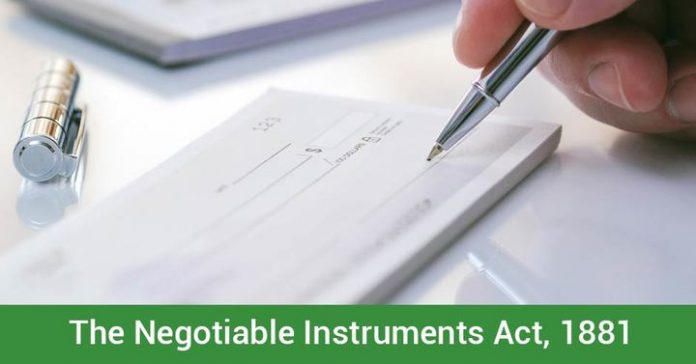THE NEGOTIABLE INSTRUMENTS ACT,1881
TOPIC-
- Negotiable Instruments- Meaning, types.
- What is a Negotiable Instrument?
A Negotiable Instrument is that document that includes a ‘promise to pay’ a certain amount of money to the bearer of the document. Its a mode of transferring a debt from one person to another. Negotiable Instruments are always in written form.
Examples of Negotiable instruments are- a cheque, a promissory note, a bill of exchange.
The best thing about Negotiable instruments is that they are easily transferrable, negotiable and a good and easy substitute for money.
Negotiable instruments are widely used for trade/business.
- Types of Negotiable Instruments?
As stated above, among the various, a cheque, a promissory note and a bill of exchange are provided under the Act which are explained in detail below-
- PROMISSORY NOTE-
A promissory note is that written document by way of which a written promise to pay a certain amount of money taken/levied from the payee is made.
The person who makes the promissory note and who lends the money from another is known as the ‘Maker’ and the person from whom such amount is lended/levied is known as the ‘Payee’.
A promissory note should always be made with that person who has the ability to repay the money. A promissory note requires two parties to come into existence.
A promissory note must always be signed by the Maker, should always be in writing, it must contain an undertaking to pay and should also bear a sufficient stamp as required under the Indian Stamp Act.
- BILL OF EXCHANGE-
Section 5 of the Act provides that a bill of exchange is that instrument which is in writing consisting of an unconditional order, which is signed by the maker in order to pay a certain amount of money to a certain person at a predetermined future date.
A bill of exchange is made between three parties namely the- drawer, drawee and payee.
A person who makes the bill of exchange is known as the drawer. A person on whom the bill is drawn is called a drawee and to whom the amount mentioned in the bill of exchange is payble is known as payee.
The difference between a promissory note and a bill of exchange is that a bill of excxhange can bind one party to pay a third party the money who was not a party to the bill of exchange at the time it was executed.
- CHEQUE-
A cheque in general is that document that orders a payment of money from a bank account. But as per Section-6 of the Negotiable Instruments Act provides that- A “cheque” is a bill of exchange drawn on a specified banker and not expressed to be payble otherwise than on demand and it includes the electronic image of a truncated cheque and the cheque in the electronic form.
A cheque is always payable by the banker only on demand and must fullfill all the requirements of a bill of exchange and can be drawn for a certain sum of money.
The person who writes the check is known as the ‘drawer’. The drawer writes the date on the cheque, writes the amount of money payable, signs it ordering his bank which is known as the ‘drawee’ to pay the amount of money stated in the cheque to such person, in the favour of whom the cheque has been signed.
A cheque is always drawn on the funds of the drawer and it does not requires any stamping.
- Kinds of cheques-
Cheques are of different kinds-
- Bearer Cheque
- Crossed Cheque
- Open cheque
- Order Cheque
- Marked Cheque
- Not payable or bad cheque
- Ante-dated Cheque
- Post dated Cheque
- Stale Cheque
- Multilated Cheque
- Digital Cheque- Cheques in Electronic form and Truncated Cheques.
- Banker Cheque
- Golden Cheque
- Travellers Cheque






best information.